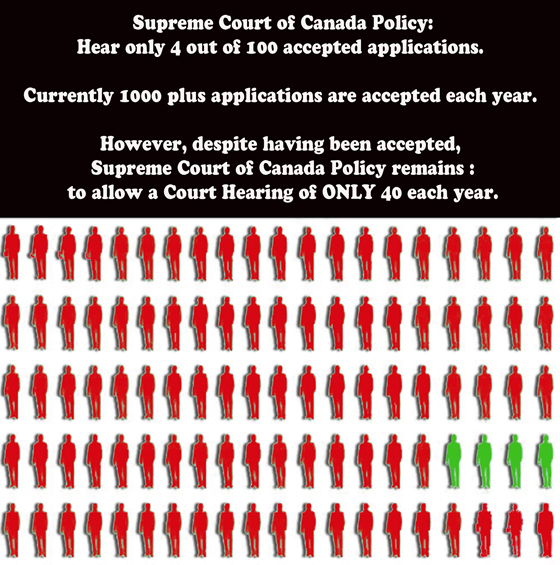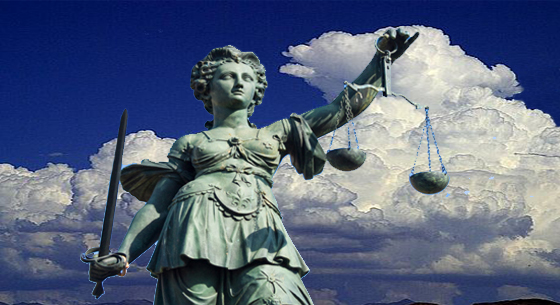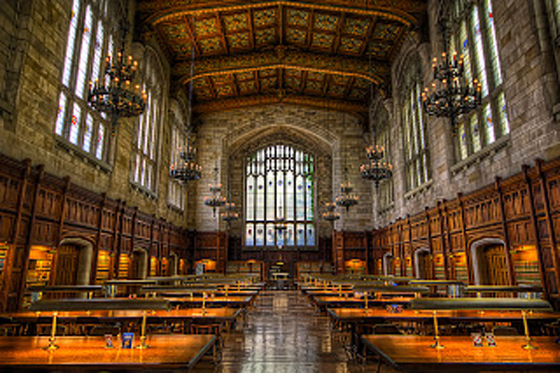The Canadian Judicial System
Judicial system Web definition:
judiciary: the system of law courts that administer justice and constitute the judicial branch of government.
The Constitutional Framework
The organization of Canada’s judicial system is a function of Canada’s
Constitution, and particularly of the
Constitution Act, 1867. By virtue
of that
Act, authority for the judicial system in Canada is divided between
the federal government and the ten provincial governments. The latter are given
jurisdiction over "the administration of justice" in the provinces,
which includes "the constitution, organization and maintenance" of
the courts, both civil and criminal, in the province, as well as civil procedure
in those courts. However, this jurisdiction does not extend to the appointment
of the judges of all of these courts. The power to appoint the judges of the
superior courts in the provinces - which includes the provincial courts of appeal
as well as the trial courts of general jurisdiction - is given to the federal
government, as is the obligation to provide for the remuneration of those judges
and the authority to remove them. This latter authority is a limited one and,
in fact, has never been exercised.
The federal government is also given the authority to establish "a General
Court of Appeal for Canada and any Additional Courts for the better Administration
of the Laws of Canada". It has used this authority to create the Supreme
Court of Canada as well as the Federal Court of Appeal, the Federal Court and
the Tax Court of Canada. The federal government also has, as part of its jurisdiction
over criminal law, exclusive authority over the procedure in courts of criminal
jurisdiction.
What emerges from these allocations of jurisdiction in the Constitution is
a court system in which provincial governments have jurisdiction over both the
constitution, organization and maintenance of, and the appointment of judges
to, the lowest level of courts (generally known simply as "provincial courts"),
while the federal government has authority over the constitution, organization
and maintenance of, and the appointment of judges to, the Supreme Court of Canada,
the Federal Court of Appeal, the Federal Court and the Tax Court of Canada.
Authority over the superior courts in each province is shared between the provincial
and federal governments; the provinces have jurisdiction over the constitution,
organization and maintenance of these courts, while the federal government has
authority to appoint the judges. The fact that jurisdiction over these courts
is divided in this way means that, in order for these courts to function properly,
the federal and provincial governments are required to cooperate in the exercise
of their respective authorities.
Organization of Courts
The courts in Canada are organized in a four-tiered structure.
The Supreme Court of Canada sits at the apex of the structure and, consistent with its role
as "a General Court of Appeal for Canada", hears appeals from both
the federal court system, headed by the Federal Court of Appeal and the provincial
court systems, headed in each province by that province’s Court of Appeal.
In contrast to its counterpart in the United States, therefore, the Supreme
Court of Canada functions as a
national, and not merely
federal,
court of last resort.
The next tier down from the Supreme Court of Canada consists of the Federal
Court of Appeal and the various provincial courts of appeal, in the Province of New Brunswick we have the
Court of Appeal of New Brunswick. Two of these latter
courts, it should be noted, also function as the courts of appeal for the three
federal territories in northern Canada, the Yukon Territory, the Northwest Territories,
and the Nunavut Territory.
The Court of Appeal of New Brunswick is the highest
court in the Province. It is the last avenue of appeal, except in a few
cases where a further appeal to the Supreme Court of Canada is possible.
The Court of Appeal generally sits in
Fredericton. It is comprised of the Chief Justice of New Brunswick, five
other judges, any former judge of the Court of Appeal who is a
supernumerary judge and any former Chief Justice of New Brunswick who is
a judge or a supernumerary judge. It hears appeals relating to a wide
variety of issues.
The next tier down consists of the Federal Court, the Tax Court of Canada and
the provincial and territorial superior courts of general jurisdiction, in the Province of New Brunswick we have the
Court of Queen's Bench of New Brunswick Trial Division, which is a superior Court of inherent jurisdiction. These
latter courts can fairly be described as the lynchpin of the Canadian judicial
system since, reflecting the role of their English counterparts (in New Brunswick we even carried the name), on which they
were modelled, they are the only courts in the system with inherent jurisdiction
in addition to jurisdiction granted by federal and provincial statutes.
Court of Queen's Bench, Trial Division
The Trial Division hears civil law matters,
excluding family disputes, which are heard in the Family Division.
Trial Division Judges also preside over criminal trials, with or without
a jury. The Trial Division hears appeals relating to summary conviction
offences tried in the Provincial Court, and the judges sit in the
Provincial Court when necessary. The Trial Division's jurisdiction is outlined in the
Judicature Act. The Trial Division holds sittings in the eight Court of Queen's Bench Judicial Districts of New Brunswick.
Court of Queen's Bench, Family Division
The Family Division deals
with all family matters such as marriages, divorces, adoptions, division
of marital property, claims for spousal and/or child support,
guardianship and custody and access. The Family Division also deals
with matters relating to consent to medical treatment of minors, changes
of name, presumptions of death, as well as matters relating to the care
of infirm persons and the management of their property. The Family Division's jurisdiction is outlined in the Judicature Act.
The Family Division holds sittings in all of the eight Judicial Districts of the Court of Queen's Bench.
Provincial Courts
At the bottom of the hierarchy are the courts typically described as provincial courts. These courts are generally divided within each province into various
divisions defined by the subject matter of their respective jurisdictions;
hence, one usually finds a Traffic Division, a Small Claims Division, a Family
Division called , a Criminal Division, and so on.
In the Province of New Brunswick, these courts divided into various
divisions defined by the subject matter of their respective jurisdictions;
What may be called Traffic Division in other provinces is called
Provincial Court, in the Province of New Brunswick: Provincial Court deals with all Municipal Bylaw matters as well as other ticketing procedures.
What may be called Small Claims Division in other provinces is called
Small Claims Court in New Brunswick. The claims are in fact heard by
Court of Queen's Bench of New Brunswick Trial Division, under special designated procedures, because the Province decided to remove that specific Court from service.
What may be called Family
Division called, in other provinces is called
Court of Queen's Bench of New Brunswick Family Division, in the Province of New Brunswick..
What may be called Criminal Division, in other provinces is called
Provincial Court, in the Province of New Brunswick: The Provincial Court is the entry point for all persons charged with offences under the
Criminal Code or other federal or provincial legislation such as
Provincial Offences Procedure Act, SNB 1987, c P-22.1,
In the Province of New Brunswick: The Provincial Court has jurisdiction to try almost all
indictable offences involving adult accused (murder being the main
exception), all offences involving youths under the
Youth Criminal Justice Act
(ages 12 to 18), and all summary conviction offences for both adults
and youths. Even in indictable matters where the accused person has an
election or choice to be tried in the Court of Queen's Bench by a judge
sitting with or without a jury, the Provincial Court may first be
required to hold a preliminary inquiry.
In the Province of New Brunswick: Provincial Court judges also receive Informations
(the documents which contain charges), issue Search Warrants,
Summonses, and Subpoenas, Warrants of Arrest, and conduct Bail Hearings
of accused persons who appear before the Court in custody, in addition
to conducting regular Court sittings on a daily basis.
In the Province of New Brunswick: Provincial Court judges also hold weekend “Remand
Court” to allow persons who have been arrested by the police to be
brought before a judge within 24 hours.
In the Province of New Brunswick: Provincial Court judges are designated as Youth
Criminal Court Judges for the purpose of dealing with young persons
between the ages of 12 and 18 years who are charged with offences.
The Provincial Court also
has a Mental Health Court in the City of Saint John. The Mental Health Court in
Saint John began as a pilot project under the direction of Judge Alfred
Brien. The model created by Judge Brien and the Mental Health Court
Team was adopted as a permanent program of the Saint John Provincial
Court on November 14, 2003. The Saint John Mental Health
Court is a fine example of the success that can be achieved when the
judiciary and various public and private agencies come together to address
an issue that pervades much of society and unfortunately finds its way
into the “mainstream of courts all too often”. This innovative
approach has developed an effective means of dealing with individuals who
come into conflict with the law as a result of a mental illness or intellectual disability.
Court Locations
There are approximately 750 court locations in Canada. The Supreme Court of
Canada sits only in Ottawa, although teleconferencing facilities to locations
across the country are available. Hence it is possible for the parties to
litigation before the Court to make their arguments in locations other than
Ottawa, and to have those arguments transmitted to the Supreme Court of Canada
via satellite. The other three federally established courts, the Federal Court
of Appeal, the Federal Court and the Tax Court of Canada, altogether have
offices at seventeen permanent locations. The provincial and territorial courts
sit at over 700 locations. These include fifteen permanent provincial and
territorial appellate court sitting locations - one in each province and territory
except for Quebec and Alberta, which have two each.
The Supreme Court of Canada
The Supreme Court of Canada was constituted in 1875 by an act of Parliament
and is now governed by the
Supreme Court Act. It is comprised of a Chief
Justice and eight puisne judges (puisne meaning ranked after), all appointed
by the Governor-in-Council for terms of "good behaviour", with a
minimum of three judges coming from Quebec. Supreme Court judges must live
within forty
kilometres of the National Capital Region.
The Supreme Court is a general court of appeal from all other Canadian courts
of law. It, therefore, has jurisdiction over disputes in all areas of the law,
including constitutional law, administrative law, criminal law and private
law.
In most cases, appeals are heard by the Court only if leave is first given.
Such leave will be given by the Court when a case involves a question of public
importance, or if it raises an important issue of law or of mixed law and fact,
or if the matter is, for any other reason, of such a nature or significance
as to warrant consideration of the Court. Leave to appeal to the Court may
also be given by a federal or provincial appellate court.
There are cases where leave is not required. In criminal cases, the
Criminal
Code gives a right of appeal where acquittal has been set aside in the
provincial court of appeal or where, in the provincial court of appeal, one
judge dissents on a point of law.
The Supreme Court does have a special kind of "reference" jurisdiction,
original in character, given by s. 53 of the
Supreme Court Act. The Governor-in-Council
may refer to the Court, for its opinion, important questions of law or fact
concerning the interpretation of the Constitution, the constitutionality or
interpretation of any federal or provincial legislation, or the powers of Parliament
or of the provincial legislatures or their respective governments or any other
important question of law or fact concerning any matter. Where the government
of any province has any special interest in any question put in reference, the
Attorney General of the province shall be notified in order that he or she may
be heard.
Constitutional questions may also be raised in regular appeals involving individual
litigants or governments or governmental agencies. In such cases the federal
and provincial governments are notified of the constitutional question and
may intervene to argue it.
In light of the broad scope of the Supreme Court of Canada’s jurisdiction,
it is clear that the Canadian judicial system differs from that of many continental
European and Latin and South American countries, where it is not unusual for
there to be separate courts of last resort for both constitutional law and
administrative law cases in addition to a general court of appeal.
Federal Courts
The Federal Court of Appeal and the Federal Court have a long history. Since
2003, they are the successors of the appeal and trial divisions of the Federal
Court of Canada, which in 1971 succeeded the Exchequer Court of Canada which
itself was created in 1875 and had jurisdiction only over revenue, the Crown
in Right of Canada as litigant, industrial and intellectual property, admiralty
and a few other subject matters regulated by federal legislation. The Federal
Court was given jurisdiction over these matters, but in addition was given the
power of judicial review with respect to decisions of federal administrative
tribunals and jurisdiction over claims with respect to several other matters
falling within federal legislative jurisdiction, including inter-provincial
transportation and communication undertakings, bills of exchange and aeronautics.
These latter grants of new jurisdiction have spawned a good deal of litigation
regarding the nature and scope of the federal government’s authority to
grant jurisdiction to courts of its own making. Generally speaking, the Supreme
Court of Canada has interpreted that power narrowly, with the result that the
Federal Courts now exercise jurisdiction over a somewhat narrower range of disputes
than was initially intended.
Tax Court of Canada
The Tax Court of Canada was established in 1983 and has as its primary responsibility,
the hearing of appeals in the area of income tax. Its predecessor, the Tax
Review Board, was an administrative tribunal.
Provincial and Territorial Superior Courts
The superior courts of each province and territory include both a
court of general trial jurisdiction and a
provincial court of appeal. A significant feature
of these courts insofar as their jurisdiction is concerned is that that jurisdiction
is not limited to matters over which the provincial governments have legislative
jurisdiction. In this respect, they are very different from the state courts
in the United States. Hence these courts have jurisdiction over disputes arising
in many of the areas over which the federal government is granted legislative
jurisdiction in the
Constitution Act, 1867 - for example, criminal law
and banking. Moreover, the power to decide disputes in such areas does not have
to be explicitly assigned to these courts by the federal government in order
for these courts to have jurisdiction over them. Hence, if federal legislation
calls for the exercise at some point of judicial authority, but says nothing
about which body is to exercise that authority, it is assumed that that authority
will reside with these courts.
As noted above, therefore, these courts can fairly be described as the lynchpin
of the Canadian judicial system.
Provincial and Territorial Courts
Although at the bottom of the hierarchy,
these courts handle the overwhelming
majority of cases that come into the Canadian court system. They deal with a
broad range of criminal matters, much of the litigation in the area of
family law, and all of the civil litigation in which the amount at issue is relatively
small. If the average citizen has occasion to become involved in a dispute that
requires adjudication on the part of a court, the likelihood is that he or she
will appear before one of these courts.
Administrative Tribunals
Although not formally part of the Canadian judicial system, because they are
not in a formal sense "courts", administrative tribunals are an integral
component of the system that has been created in Canada by government to resolve
disputes. No description of the latter system would be complete without mention
being made of these important bodies. Some areas - for example, labour relations
(both in the unionized and in the non-unionized sectors of the economy) and
individual claims of discrimination in areas like employment, housing and access
to services and facilities customarily available to the public - are dealt with
almost exclusively by them.
In the case of some of these administrative tribunals, the courts are limited
in their supervisory jurisdiction to ensuring that the tribunals do not exceed
the jurisdiction given them by their enabling statutes; insofar as these tribunals
are concerned, the final say on questions of law that arise within their jurisdiction
rests with them, not with the courts. This is generally true in the case of
labour relation tribunals. In the case of other tribunals, such as those established
to deal with claims of discrimination, the courts exercise a broader supervisory
authority which extends not only to ensuring that jurisdiction is not exceeded,
but also to reviewing decisions on questions of law that arise within jurisdiction.
However, even in the case of these latter tribunals, the courts have often,
at least in recent years, tended to show a good deal of deference to these tribunals
when reviewing decisions of the latter kind.
The Judiciary
All members of the judiciary in Canada, regardless of the court, are drawn
from the legal profession. In the case of those judges appointed by the federal
government, which includes the judges of all of the courts apart from those
at the bottom of the hierarchy and described generally as provincial courts,
are required by federal statute to have been a member of a provincial or territorial
bar for at least ten years. Lawyers wishing to become judges must apply to do
so and their applications are vetted initially by committees established within
the various jurisdictions for that purpose, with the ultimate power of decision
residing with the federal cabinet. Analogous systems operate within the respective
provinces for appointments to the provincial courts.
All judges in Canada are subject to mandatory retirement. In the case of some
of the judges appointed by the federal government, the age of retirement is
fixed by the
Constitution Act, 1867, at 75. In the case of all other
judges, both federally and provincially appointed, the age is fixed by statute,
at either 75 or 70, depending on the court.
The independence of the judiciary in Canada is guaranteed both explicitly and
implicitly by different parts of the
Constitution of Canada. This independence
is understood to consist in security of tenure, security of financial remuneration
and institutional administrative independence.































